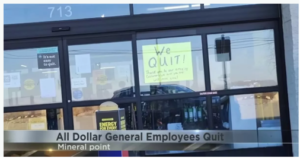Employees want to feel a sense of commitment to their work. And in return for that sense of real, authentic meaning, they will be willing to give more of themselves, aspire to higher productivity, spiraling innovation, and off-the-charts customer satisfaction.
Of these three rewards, the highest correlation exists between employee engagement and customer satisfaction. These two are more closely linked than sleeping pills with sleep, or ibuprofen with pain reduction (Moore and Humphrey, “The link between customer engagement and employee engagement”). What is more, sustainably high customer satisfaction rates are highly correlated with revenue growth, as I have pointed out elsewhere. This chain reaction, from employee to revenue growth, leaves little doubt that engagement is highly desirable.
So how do the best companies develop employee engagement? What sets the best, most inspiring engagement programs apart from lackluster lip service? I have compiled and analyzed a short list of case studies, taken from six Fortune 500 companies, so that we can answer these questions. The results are inspiring.
My office has identified 5 best practices; this article will deal with just two things leadership must do in order to create an environment where engagement is possible. Leadership needs to: 1) Make a commitment to employees; and 2) Let go of real responsibility, acknowledging that employees are responsible for fulfilling an important role in the company.
Employees and Leaders Commit to Each Other — DTE Energy
Engaging leaders do not expect commitment without making a commitment themselves. Some leaders have so much energy around them that their commitment might not need to be expressed in words (I am thinking about Steve Jobs), but many leaders need to search for an authentic connecting point between themselves and employees.
In 2008, Detroit, DTE Energy CEO Gerard M. Anderson made an important announcement to employees, which forged that connective tissue. In the middle of the economic crisis, he and employees were fearful of the stability of the business — from two different perspectives. Employees feared they would be laid off; Anderson and the C-suite feared that profitability and revenues would drop.
His answer was to make a commitment. He pledged to keep employment secure through the economic crisis; he also asked employees to help keep the company stable and profitable.
This simple statement signified the beginning of an authentic relationship between DTE workers and leadership, which continues to generate value for the company today. DTE reported continuous profits through the crisis, despite watching neighboring companies shut their doors. Success was attributed to the commitment and determination of the workers who helped keep the company afloat with nothing but good, hard work. No one was laid off, and DTE is still in the top 29% of its industry as of 2018 (DNA of Engagement, 2018).
Assuredly, the CEO’s commitment was meaningful because the terms of the deal increased job security at the very moment when job security was questioned. But at the same time, Anderson delivered responsibility back to employees, acknowledging them as the primary value drivers. He empowered them with a direct stake in their own financial security. Suddenly, there was something to lose, and something to gain.
Customer Experience consultants have seen the same pattern elsewhere. Some of the world’s most profitable, fastest growing companies are experimenting with holacracy and other self-organizing modes of governance, which decentralize authority and deliver real responsibility to middle managers and customer-facing workers. I suspect these models work not only in terms of organizational agility, but also on a psychological level to create that sense of commitment, having a stake in the business.
Our next case study will refine this idea even further by showing a multifaceted approach to commitment.
Driving Employee Retention at the Point of Influence – USAA
“Our member experience can’t be any greater than our employee experience because our employees serve our members.” Cecilia Pardo AVP, Employee Experience, USAA
- The average turnover rate for employees in the United States is 2.7 years (US Bureau of Labor Statistics, April 2018). On average, a member of the workforce changes jobs every 2.7 years.
- The average tenure of a C-Suite Member is 5.3 years (Korn Ferry, 2017).
- The United Services Automobile Association has 30,300 employees, and on average they retain employees for more than eight years, almost twice as long as the average CIO.
How do they do it? This $27.1 billion company places responsibility for employee retention very squarely into the hands of, well, employees. CEO Stuart Parker and, in fact, all senior leaders set goals for their employee experience and work hard to empower those initiatives that make a measurable, positive impact on the work environment. These goals are then measured through pulse surveys and engagement data and analytics, so that leadership can address areas of weakness and continuously improve.
If you pulled out the textbook on Employee Engagement, all the above would have chapters: none of this is truly exceptional. The company’s real innovation lies in its retention program. The retention program offers direct incentive to the entire workforce for achieving or exceeding the company’s annual goal. When the goal is met (as it has been for every year since inception), every employee receives a bonus to their paycheck. Every employee is incentivized to help cultivate an environment where cohorts want to stay. Management ensures the incentive is channeled to positive reinforcement activities by training managers on servant leadership and focusing on the employee experience at the employee level. It works.
The model is a powerful example in numerous ways. First, I would like to reemphasize the commitment of the leadership team, which is seen not only as a commitment, but executed thoughtfully, thoroughly, and meaningfully. Second, responsibility is recognized and rewarded at the point of influence. Company culture is set by the company, in part, but employee experience is created in large part by employees. Recognizing that this is true, and rewarding the point of influence for a job well done, is a pattern we see repeatedly in the most competitive companies today.
Takeaway: Successful Employee Engagement Is a Contract between Leadership and Employees
We have seen two very persuasive data points, and both show how leadership can engage employees by making a commitment and by delegating responsibility. Executives will see these ideas distill into a series of simple actions:
- Identify what you want from employees
- Identify what your employees most value about their work or what you can give them
- Forge a deal to bring these two needs together, giving employees direct responsibility and accountability for their part of the bargain
- Support employees and execute your side
This is not complicated stuff. It is also interesting and important to note that this contract is not necessarily for life, but the impact of forging an authentic union between leadership and employees can still echo into the decades. DTE specifically resorted to employee engagement only to help them make it through a crisis situation, but this agreement initiated a beautiful relationship, which continues to breathe fire into their productivity today.
Stay tuned for my next article on Employee Value Propositions (EVPs), another great tool you can use to drive engagement, customer satisfaction, and profits.
Sources
Conference Board, The. “DNA of Engagement: Moments That Matter Throughout the Employee Lifecycle.” The Conference Board: New York, NY, 2018.
Korn Ferry. “Age and Tenure in the C-Suite: Korn Ferry Institute Study Reveals Trends by Title and Industry.” Korn Ferry: Los Angeles, CA. February 14, 2017.
Simon Moore and Chris Humphrey. “The link between customer engagement and employee engagement.” engage customer: November, 2016. Accessed June 28, 2018.
US Bureau of Labor Statistics, “Job Openings and Labor Turnover summary.” US Dept. of Labor, Washington D.C., June 5, 2018.






